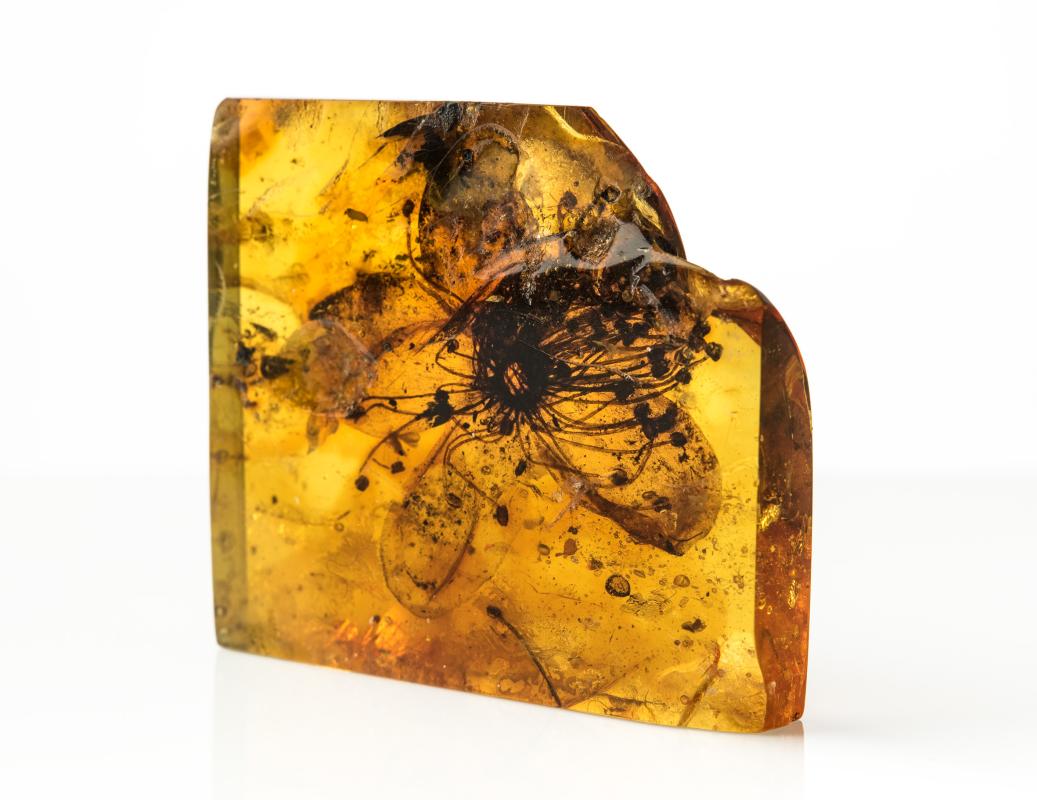If you are lucky, you will find amber on a beach stroll along the Baltic Sea. The fossilized resin lumps are washed up with onshore wind especially after stormy winter days.
A team of researchers from the Museum für Naturkunde Berlin makes past forests come alive through plant inclusions in amber, buy using the amber collection of the museum.
Past Ecosystems
“The goal is to examine plant inclusions in amber, to identify them and to draw conclusions about their ecosystems,” said palaeobotanist Eva-Maria Sadowski. Some of the plant parts enclosed in resin flows millions of years ago – usually leaves, flowers or seeds of less than one centimetre in size – are well preserved in shape and even on cellular level.
“We can use these objects to understand distribution patterns and morphological evolution of plant families,” said Sadowski. Further questions concern the resin itself. With Baltic amber, for example, it is unclear which plant produced so much resin and which factors caused mass resin production.
The first step in the investigations is to find useable specimens for study. “I am very fortunate to be able to work with pre-sorted collections, including some from private collectors,” said Sadowski.
With Baltic amber, only about one in a thousand pieces has an inclusion. Only two to three out of a hundred inclusions are plant material. Of these, only a small fraction is suitable for in-depth research.
In a project approved by the German Research Foundation, Sadowski and her doctoral student Simon Beurel investigate amber inclusions from Myanmar and China. The specimens originate from the Middle Cretaceous about 98 million years ago and the Middle Miocene about 15 million years ago. The recently discovered finds from both countries have so far been little examined for traces of past plant communities. The new findings from this project contribute to our understanding of the rapid spread and diversification of flowering plants in the Cretaceous period. They also provide insights into the resin-producing forests of the time, their biodiversity and habitats.
Promising revisions
In the Museum’s amber laboratory, some of the amber specimens are ground and polished to optimize the visual investigation of the inclusion. Next, the amber inclusions are examined and photographed using a light microscope. In some cases, small samples are extracted from the inclusions for electron microscopic examinations. The palaeobotanist and her team also apply micro-computed tomography at the Museum and the Deutsches Elektronen-Synchrotron (DESY, Hamburg) to reveal internal structures of the plant inclusions.
The Museum für Naturkunde Berlin preserves one of the largest and most valuable collections of Baltic and Bitterfeld amber in Europe. Many of the finds have only been examined once so far and some of the related publications are more than one hundred years old. They are often scientifically outdated, but are still being cited. “Revising these first descriptions by applying new technologies and the current state of knowledge is very promising,” said Sadowski.
In a new project funded by the German Research Foundation, Sadowski and her doctoral student Josephine Franke are researching these historical specimens, with focusing on flowering plants of Baltic amber. These specimens are further pieces of the puzzle to better understand the forest where the amber originated from. This is because both its plant diversity and its climate have not yet been comprehensively analyzed.
“New findings about the plant communities of the Baltic amber forest are also essential to understand the habitat for thousands and thousands of insects and arachnids known from this amber,” says Sadowski.
Related Publications
- Beurel S, Bachelier JB, Schmidt AR, Sadowski E-M. 2024. Novel three-dimensional reconstructions of presumed Phylica (Rhamnaceae) from Cretaceous amber suggest Lauralean affinities, Nature Plants 10: 223-227. 10.1038/s41477-023-01592-w
- Beurel S, Bachelier JB, Munzinger J, Shao F, Hammel JU, Shi GL, Sadowski E-M. 2024. First flower inclusion and fossil evidence of Cryptocarya (Laurales, Lauraceae) from Miocene amber of Zhangpu (China). Fossil Record 27: 1-11. https://doi.org/10.3897/fr.27.109621
- Beurel S, Bachelier JB, Hammel JU, Shi GL, Wu XT, Rühr PT, Sadowski E-M. 2023. Flower inclusions of Canarium (Burseraceae) from Miocene Zhangpu amber (China). Palaeoworld 32: 592-606. https://doi.org/10.1016/j.palwor.2023.02.006
- Sadowski E-M, Hofman C-C. 2023. The largest amber-preserved flower revisited. Scientific Reports 13: 17. https://doi.org/10.1038/s41598-022-24549-z
- Sadowski E-M, Schmidt AR, Kunzmann L. 2022. The hyperdiverse conifer flora of the Baltic amber forest. Palaeontographica B 304: 1–148. DOI: 10.1127/palb/2022/0078
- Wang B, Shi G, Xu C, Spicer RA, Perrichot V, Schmidt AR, Feldberg K, Heinrichs J, Chény C, Pang H, Liu X, Gao T, Wang Z, Slipinski A, Solórzano-Kraemer MM, Heads SW, Thomas MJ, Sadowski E-M, Szwedo J, Azar D, Nel A, Liu Y, Chen J, Zhang Q, Zhang Q, Luo C, Yu T, Zheng D, Zhang H, Engel MS. 2021. The mid-Miocene Zhangpu biota reveals an outstandingly rich rainforest biome in East Asia. Science Advances 7: eabg0625. DOI: 10.1126/sciadv.abg0625
- Sadowski E-M, Schmidt AR, Denk T. 2021. Staminate inflorescences with in situ pollen from Eocene Baltic amber reveal high diversity in Fagaceae (oak family). Willdenowia 50(3): 405–517. doi: https://doi.org/10.3372/wi.50.50303
- Sadowski E-M, Hammel JU, Denk T. 2018. Synchrotron X-ray imaging of a dichasium cupule of Castanopsis from Eocene Baltic amber. American Journal of Botany, 105 (12): 2025-2036. https://doi.org/10.1002/ajb2.1202
- Sadowski E-M, Schmidt, AR, Seyfullah LJ, Kunzmann L. 2017. Conifers of the ‘Baltic amber forest’ and their palaeoecological significance. Stapfia, 106: 1-73. ISSN 0252-192X
Project-titel
Reconstructing fossil-rich East Asian amber forests using inclusions of seed plants (Project number 423862824)
Towards a holistic reconstruction of the ‘Baltic amber forest’ – angiosperm diversity and its palaeoecological implications (Project number 535296903)
